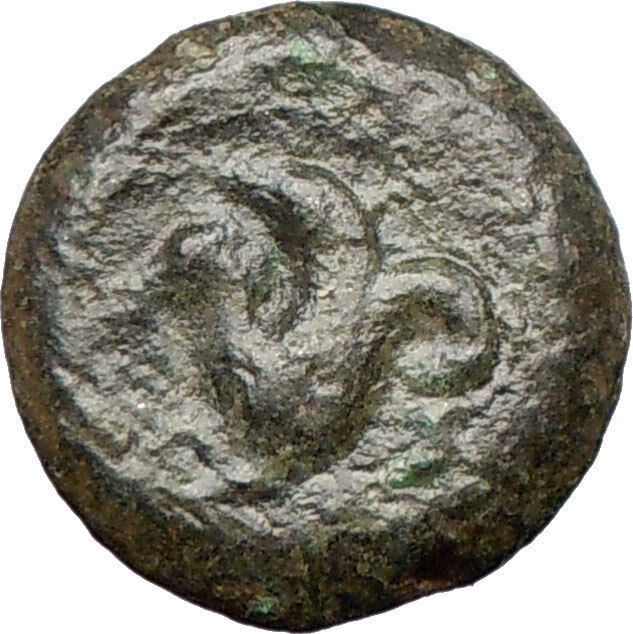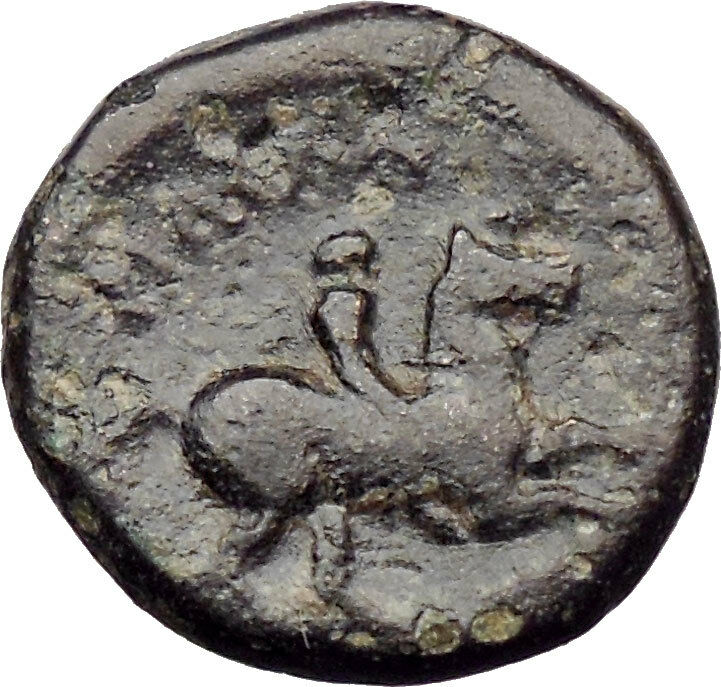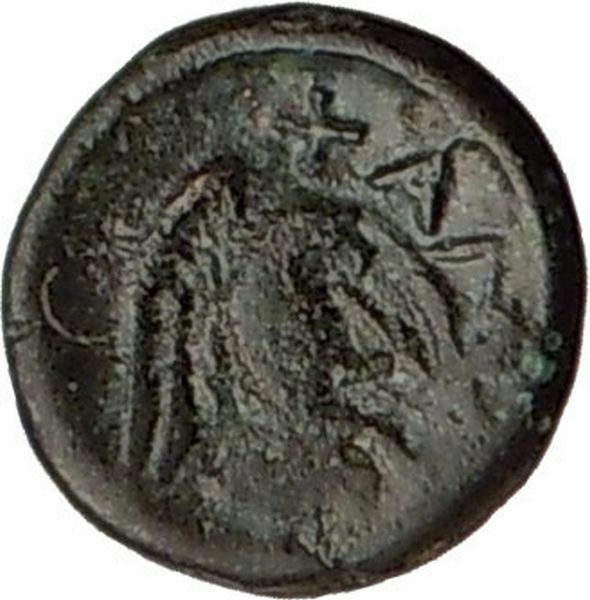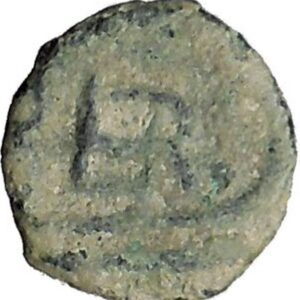|
Greek Coin of Dynasts of Lycia<span class="mw-headline" id="History" history
Perikles – Dynast circa 390-360 B.C.
Silver Third Stater / Tetrobol 16mm (2.84 grams) Struck circa 390-360 B.C.
Reference: SNG von Aulock 4254-4255 var.
Certification: NGC Ancients Ch AU Strike: 4/5 Surface: 5/5 4680931-013
Lion’s scalp facing.
Triskeles.
Dynast of Antiphellos from circa 390 B.C., Perikles had extended his rule over most of Lycia by the time of his death, about 360 B.C.
You are bidding on the exact item pictured, provided with a Certificate of Authenticity and Lifetime Guarantee of Authenticity.
A triskelion or triskele (which invariably has rotational symmetry) is a motif consisting of three interlocked spirals, or three bent human legs. Both words are from Greek “τρισκέλιον” (triskelion) or “τρισκελής” (triskeles), “three-legged”, from prefix “τρι-” (tri-), “three times” + “σκέλος” (skelos), “leg”. Although it appears in many places and periods, it is especially characteristic of the Celtic art of the La Tène culture of the European Iron Age.
A triskelion is the symbol of Sicily, where it is called trinacria, as well as of the Isle of Man, Brittany and the town of Füssen in Germany.
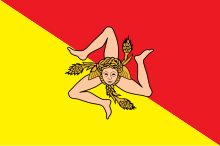
The flag of Sicily, featuring the triskelion symbol revived by Joachim Murat
The triskelion symbol appears in many early cultures, including western civilization’s earliest known astronomical calendar at the famous megalithic tomb of Newgrange in Ireland built around 3200 BC, Mycenaean vessels, on coinage in Lycia, and on staters of Pamphylia (at Aspendos, 370-333 BC) and Pisidia. It appears as a heraldic emblem on warriors’ shields depicted on Greek pottery.
Familiar as an ancient symbol of Sicily, the symbol dates back to when Sicily was part of Magna Graecia, the colonial extension of Greece beyond the Aegean. Pliny the Elder attributes the origin of the triskelion of Sicily to the triangular form of the island, the ancient Trinacria (from the Greek tri- (three) and akra (end, limb)), which consists of three large capes equidistant from each other, pointing in their respective directions, the names of which were Pelorus, Pachynus, and Lilybæum.
The Celtic symbol of three conjoined spirals may have had triple significance similar to the imagery that lies behind the triskelion. The triple spiral motif is a Neolithic symbol in Western Europe. It is considered a Celtic symbol but is in fact a pre-Celtic symbol. It is carved into the rock of a stone lozenge near the main entrance of the prehistoric Newgrange monument in County Meath, Ireland. Newgrange which was built around 3200 BCE predating the Celtic arrival in Ireland but has long since been incorporated into Celtic culture.
 Lycia was a geopolitical region in Anatolia in what are now the provinces of Antalya and Muğla on the southern coast of Turkey, and Burdur Province inland. Known to history since the records of ancient Egypt and the Hittite Empire in the Late Bronze Age, it was populated by speakers of the Luwian language group. Written records began to be inscribed in stone in the Lycian language (a later form of Luwian) after Lycia’s involuntary incorporation into the Achaemenid Empire in the Iron Age. At that time (546 BC) the Luwian speakers were decimated, and Lycia received an influx of Persian speakers. Lycia was a geopolitical region in Anatolia in what are now the provinces of Antalya and Muğla on the southern coast of Turkey, and Burdur Province inland. Known to history since the records of ancient Egypt and the Hittite Empire in the Late Bronze Age, it was populated by speakers of the Luwian language group. Written records began to be inscribed in stone in the Lycian language (a later form of Luwian) after Lycia’s involuntary incorporation into the Achaemenid Empire in the Iron Age. At that time (546 BC) the Luwian speakers were decimated, and Lycia received an influx of Persian speakers.
Lycia fought for the Persians in the Persian Wars, but on the defeat of the Achaemenid Empire by the Greeks, it became intermittently a free agent. After a brief membership in the Athenian Empire, it seceded and became independent (its treaty with Athens had omitted the usual non-secession clause), was under the Persians again, revolted again, was conquered by Mausolus of Caria, returned to the Persians, and went under Macedonian hegemony at the defeat of the Persians by Alexander the Great. Due to the influx of Greek speakers and the sparsity of the remaining Lycian speakers, Lycia was totally Hellenized under the Macedonians. The Lycian language disappeared from inscriptions and coinage.
On defeating Antiochus III in 188 the Romans gave Lycia to Rhodes for 20 years, taking it back in 168 BC. In these latter stages of the Roman republic Lycia came to enjoy freedom as part of the Roman protectorate. The Romans validated home rule officially under the Lycian League in 168 BC. This native government was an early federation with republican principles; these later came to the attention of the framers of the United States Constitution, influencing their thoughts.
Despite home rule under republican principles Lycia was not a sovereign state and had not been since its defeat by the Carians. In 43 AD the Roman emperor Claudius dissolved the league. Lycia was incorporated into the Roman Empire with a provincial status. It became an eparchy of the Eastern, or Byzantine Empire, continuing to speak Greek even after being joined by communities of Turkish language speakers in the early 2nd millennium. After the fall of the Byzantine Empire in the 15th century, Lycia was under the Ottoman Empire, and was inherited by the Turkish Republic on the fall of that empire. The Greeks were withdrawn when the border between Greece and Turkey was negotiated in 1923.
The eponymous inhabitants of Lycia, the Lycians, spoke Lycian, a member of the Luwian branch of the Anatolian languages, a subfamily of the Indo-European family. Lycian has been attested only between about 500 BC and no later than 300 BC, in a unique alphabet devised for the purpose from the Greek alphabet of Rhodes. However, the Luwian languages originated in Anatolia during the 2nd millennium BC. The country was known by the name of Lukka then, and was under Hittite rule. The gap must be a gap in the use of writing.
At about 535 BC, before the first appearance of attested Lycian, the Achaemenid Empire overran Lycia. Despite its resistance, because of which the population of Xanthus was decimated, Lycia became part of the Persian Empire. The first coins with Lycian letters on them appeared not long before 500. Lycia prospered under a monarchy set up by the Persians. Subsequently the Lycians were verbose in stone, carving memorial, historical and governmental inscriptions. Not all of these can yet be entirely understood, due to remaining ignorance of the language. The term “dynastic period” is used. If the government was any sort of federal democracy, there is no evidence of it, as the term “dynastic” suggests.
Lycia already had been hosting a small enclave of the Dorian Greeks as Doris for some centuries. Rhodes also was Dorian. After the defeat of the Persians by the Greeks, Lycia became open to further Greek settlement. Inscriptions in Lycian diminished, while those in Greek multiplied. Complete assimilation to Greek occurred in the 4th century, after Lycia had come under Alexander the Great and his fellow Macedonians. There is no agreement yet on which Lycian inscription is the very last. No date is later than 300 at the very latest.
Subsequently the Macedonians were defeated by the Roman Republic, which for most of its final tenure allowed home rule to the Lycians, including their own language, then Greek. Lycia continued under the single empire, and fell naturally into the eastern empire when the division occurred. It was still speaking the Greek of the times when the eastern empire became the Byzantine Empire. In the 2nd millennium Anatolia was infiltrated by Turkish speaking settlers, but they never were very numerous in Lycia. After the fall of the Byzantines in the 15th century, Lycia was under the Ottoman Empire. Turkish and Greek settlements existed side-by-side, each speaking their own language.
All Greek-speaking enclaves in Anatolia were exchanged for Turkish speakers in Greece during the final settlement of the border with Greece at the beginning of the Turkish Republic in 1923. The Turks had won wars with Greece and Armenia in the preceding few years, settling the issue of whether the coast of Anatolia was going to be Greek or Turkish. The intent of the Treaty of Lausanne was to define borders that would not leave substantial populations of one country in another. Some population transfers were enforced. Former Greek villages still stand as ghost towns in Lycia.
Herodotus writes more credibly of contemporaneous events, especially where they concerned his native land. Asia Minor had been partly conquered by the Iranians, starting with the Scythians, then the Medes. The latter were defeated by the Persians, who incorporated them and their lands into the new Persian Empire. Cyrus the Great, founder of the Achaemenid dynasty, resolved to complete the conquest of Anatolia as a prelude to operations further west, to be carried out by his successors. He assigned the task to Harpagus, a Median general, who proceeded to subdue the various states of Anatolia, one by one, some by convincing them to submit, others through military action.
Arriving at the southern coast of Anatolia in 546 BC, the army of Harpagus encountered no problem with the Carians and their immediate Greek neighbors and alien populations, who submitted peacefully. In the Xanthus Valley an army of Xanthians sallied out to meet them, fighting determinedly, although vastly outnumbered. Driven into the citadel, they collected all their property, dependents and slaves into a central building, and burned them up. Then, after taking an oath not to surrender, they died to a man fighting the Persians, foreshadowing and perhaps setting an example for Spartan conduct at the Battle of Thermopylae a few generations later. Coincidentally archaeology has turned up a major fire on the acropolis of Xanthus in the mid-6th century BC, but as Antony Keen points out, there is no way to connect that fire with the event presented by Herodotus. It might have been another fire. The Caunians, says Herodotus, followed a similar example immediately after. If there was an attempt by any of the states of Lycia to join forces, as happened in Greece 50 years later, there is no record of it, suggesting that no central government existed. Each state awaited its own fate alone.
Herodotus also says or implies that 80 Xanthian families were away at the time, perhaps with the herd animals in alpine summer pastures (pure speculation), but helped repopulate the place. However, he reports, the Xanthians of his time were mainly descended from non-Xanthians. Looking for any nuance that might shed light on the repopulation of Xanthus, Keen interprets Herodotus’ “those Lycians who now say that they are Xanthians” to mean that Xanthus was repopulated by other Lycians (and not by Iranians or other foreigners). Herodotus says nothing of the remainder of Lycia; presumably, that is true because they submitted without further incident. Lycia was well populated and flourished as a Persian satrapy; moreover, they spoke mainly Lycian.
The Harpagid theory
The Harpagid Theory was initiated by Charles Fellows, discoverer of the Xanthian Obelisk, and person responsible for the transportation of the Xanthian Marbles from Lycia to the British Museum. Fellows could not read the Lycian inscription, except for one line identifying a person of illegible name, to whom the monument was erected, termed the son of Arppakhu in Lycian, equivalent to Greek Harpagos. Concluding that this person was the conqueror of Lycia in 546, Fellows conjectured that Harpagos had been made permanent satrap of Lycia for his services; moreover, the position was hereditary, creating a Harpagid Dynasty. This theory prevailed nearly without question for several generations.
To the inscriptions of the Xanthian Obelisk were added those of the Letoon trilingual, which gave a sequel, as it were, to the names on the obelisk. Studies of coin legends, initiated by Fellows, went on. Currently most, but not all, of the Harpagid Theory, has been rejected. The Achaemenids utilized no permanent satrapies; the political circumstances changed too often. The conqueror of new lands was seldom made their satrap; he went on to other conquests. It was not the Persian custom to grant hereditary satrapies; satrap was only a step in the cursus honorum. And finally, a destitute mountain country would have been a poor reward for Cyrus’ best general. The main evidence against the Harpagid Theory (as Keen calls it) is the reconstruction of the name of the Xanthian Obelisk’s deceased as Lycian Kheriga, Greek Gergis (Nereid Monument), a king reigning approximately 440-410 BC, over a century later than the conqueror of Lycia.
The next logical possibility is that Kheriga’s father, Arppakhu, was a descendant of the conqueror. In opposition, Keen reconstructs the dynastic sequence from coin inscriptions as follows. Kheriga had two grandfathers, Kuprlli and Kheriga. The younger Kheriga was the successor of Kuprlli. The latter’s son, therefore, Kheziga, who was Kheriga’s uncle, must have predeceased Kuprlli. Arppakhu is listed as regnant on two other inscriptions, but he did not succeed Kuprlli. He must therefore have married a daughter of Kuprlli, and have also predeceased the long-lived Kuprlli. The latter then was too old to reign de facto. On the contemporaneous deaths of both him and his son-in-law, Kheriga, named after his paternal grandfather, acquired the throne.
Kuprlli was the first king recorded for certain (there was an earlier possible) in the coin legends. He reigned approximately 480-440. Harpagos was not related by blood. The conqueror, therefore, was not the founder of the line, which was not Harpagid. An Iranian family, however, producing some other Harpagids, did live in Lycia and was of sufficient rank to marry the king’s daughter. As to whether the Iranian family were related to any satrap, probably not. Herodotus says that Satrapy 1 (the satrapies were numbered) consisted of Ionia, Magnesia, Aeolia, Caria, Lycia, Milya, and Pamphylia, who together paid a tax of 400 silver talents. This satrapy was later broken up and recombined. Keen hypothesizes that since Caria had responsibility for the King’s Highway through Lycia, Lycia and Caria were a satrapy.
The Lycian monarchy
The Achaemenid policy toward Lycia was hands-off. There was not even a satrap stationed in the country. The reason for this tolerance after such a determined initial resistance is that the Iranians were utilizing another method of control: the placement of aristocratic Persian families in a region to exercise putative home rule. There is some evidence that the Lycian population was not as docile as the Persian hand-off policy would suggest. A section of the Persepolis Administrative Archives called the Persepolis Fortification Tablets, regarding the redistribution of goods and services in the Persepolis palace economy, mentions some redistributed prisoners of war, among whom were the Turmirla or Turmirliya, Lycian Trm̃mili, “Lycians.” They lived during the reign of Darius I (522-486), the tablets dating from 509.
For closer attention to their conquered, the Persian government preferred to establish a client state, setting up a monarchy under their control. The term “dynast” has come into use among English-speaking scholars, but that is not a native term. The Lycian inscriptions indicate the monarch was titled xñtawati, more phonetically khñtawati. The holders of this title can be traced in coin legends, having been given the right to coin. Lycia had a single monarch, who ruled the entire country from a palace at Xanthos. The monarchy was hereditary, hence the term “dynast.” It was utilized by Persia as a means of transmitting Persian policy. It must have been they who put down local resistance and transported the prisoners to Persepolis, or ordered them transported. Some members of the dynasty were Iranian, but mainly it was native Lycian. If the survivors of 546 were in fact herdsmen (speculation), then all the Xanthian nobility had perished, and the Persians must have designated some other Lycian noble, whom they could trust.
The first dynast is believed to be the person mentioned in the last line of the Greek epigram inscribed on the Xanthian Obelisk, which says “this monument has brought glory to the family (genos) of ka[]ika,” which has a letter missing. It is probably not *karikas, for Kherika, as the latter is translated in the Letoon trilingual as Gergis. A more likely possibility is *kasikas for Kheziga, the same as Kheriga’s uncle, the successor to Kuprlli, who predeceased him.
Herodotus mentions that the leader of the Lycian fleet under Xerxes in the Second Persian War of 480 BC was Kuberniskos Sika, previously interpreted as “Cyberniscus, the son of Sicas,” two non-Lycian names. A slight regrouping of the letters obtains kubernis kosika, “Cybernis, son of Cosicas,” where Cosicas is for Kheziga. Cybernis went to the bottom of the Straits of Salamis with the entire Lycian fleet in the Battle of Salamis, but he may be commemorated by the Harpy Tomb. According to this theory, Cybernis was the KUB of the first coin legends, dated to the window, 520-500. The date would have been more towards 500.
There is a gap, however, between him and Kuprlli, who should have had a father named the same as his son, Kheziga. The name Kubernis does not appear again. Keen suggests that Darius I created the kingship on reorganizing the satrapies in 525, and that on the intestate death of Kubernis in battle, the Persians chose another relative named Kheziga, who was the father of Kuprlli. The Lycian dynasty may therefore be summarized as follows:
KosikasKhezigaFirst of the line.525 – ?KubernisKUBSecond in succession, son of the former.? – 480KosikasKhezigaThird in succession, unknown relative.480 – ? ?Kuprlli (ΚΟ𐊓, pronounced kop)Fourth in succession, son of the former. ? – 440KosikasKhezigaRegent, son of the former.? – ?Harpagus (Iranian name)ArppakhuRegent, son-in-law of Kuprlli. ? – 440GergisKherigaFifth in succession, son of the former.440-410?KhereiSixth in succession, brother of the former.410-390Arbinas (Iranian name)ErbinaSeventh in succession, son of the former. The last known of the line.390-380Artembares (Iranian name, *Rtambura, self-identified as “the Mede.”)Arttum̃paraRuler of western Lycia from Telmessos.380 – ?Pericles (Greek name)PerikleRuler of eastern Lycia from Limyra, victor over Arttum̃para, rebel in the Revolt of the Satraps, last Lycian king. ? – 360
Classical period
Following the ousting of the Persians, as Athens and Sparta fought the Peloponnesian wars, the majority of Lycian cities defaulted from the Delian League, with the exception of Telmessos and Phaselis.
In 429 BC, Athens sent an expedition against Lycia to try to force it to rejoin the league. This failed when Lycia’s leader Gergis of Xanthos defeated General Melasander. The Lycians once again fell under Persian domination, and were ruled by men such as Mithrapata (late 4th century BC), whose name was Persian, and by 412 BC, Lycia is documented as fighting on the winning side of Persia. The Persian satraps were re-installed, but (as the coinage of the time attests) they allowed local dynasts the freedom to rule. Persia held Lycia until it was conquered by Alexander III (the Great) of Macedon during 334-333 BC.
Hellenistic period
After the death of Alexander the Great in 324 BC, his generals fought amongst themselves over the succession. Lycia fell into the hands of the general Antigonus by 304 BC. In 301 BC Antigonus was killed by an alliance of the other successors of Alexander, and Lycia became a part of the kingdom of Lysimachus, who ruled until he was killed in battle in 281 BC. By 240 BC Lycia was part of the Ptolemaic Kingdom, centred on Egypt, and remained in their control through 200 BC. It had apparently come under Seleucid control by 190 BC, when the Seleucids’ defeat in the Battle of Magnesia resulted in Lycia being awarded to Rhodes in the Peace of Apamea in 188 BC. It was then granted autonomy as a protectorate of Rome in 168 BC and remained so until becoming a Roman province in 43 AD under Claudius.
Lycian League
The Lycian League (Lukiakou systema in Strabo’s Greek transliterated, a “standing together”) is first known from two inscriptions of the early 2nd century BC in which it honors two citizens. Bryce hypothesizes that it was formed as an agent to convince Rome to rescind the annexation of Lycia to Rhodes. Lycia had been under Rhodian control since the Peace of Apamea in 188 BC. A fragment from Livy records a “pitiful embassy” in 178 BC from Lycia to the Roman Senate complaining that the Lycians were being treated as slaves. Whipping had been instituted as corporeal punishment and the women and children were being abused. The Romans sent back a stern warning with the Lycians to Rhodes saying that they had not intended the Lycians or any other people born in freedom to be enslaved by Rhodes, and that the assignment was only a protectorate. A fragment from Polybius tells a slightly different version of the story, which has the Romans sending legates to Rhodes to say that “the Lycians had not been handed over to Rhodes as a gift, but to be treated like friends and allies.” The Rhodians sent an embassy in return claiming that the Lycians had made the story up for reasons of their own and that in fact they were a financial burden on Rhodes.
The continuation of the story did not survive, but in 168 BC, Rome took Lycia away from Rhodes and turned over home rule to the League. There was no question of independence. Lycia was not to be sovereign, only self-governing under republican principles. It could neither negotiate with foreign powers nor disobey the Roman Senate. It was not independent. It could govern its own people and for a time mint its own coins as a right granted by Rome. It did not determine its own borders. Land and people could be assigned or taken away by the Senate. Remarking on this protectorate Strabo says of the government:
“Formerly they deliberated about war and peace, and alliances, but this is not now permitted, as these things are under the control of the Romans. It is only done by their consent, or when it may be for their own advantage.”
Exactly what such a statement might imply is uncertain. Lycia had not been a sovereign state for some time. Whether the Lycian League as such is meant, implying that it existed anciently, or some other similar government is meant, is not clear. The statement does not say also whether there was a gap between the former sovereign state and the new Lycian League, or whether they are to be conceived as chronologically continuous.
An inscription from Tyberissos records the treaty between Rome and Lycian League, which is of a type the Romans called a foedus. It was much used between Italian cities and Rome, except that their treaties provided for contributions to Rome, but this one does not. There is a general statement and four clauses. The general statement establishes “peace, friendship, and loyal alliance … by land and sea for all time.” The four clauses provide for neutrality of Rome to the enemies of the Lycian League, neutrality of the Lycian League to the enemies of Rome, mutual assistance in the case of first aggression by an enemy against either, and alteration of the treaty only by joint agreement. The treaty is written as though between independent and co-equal states, but all parties knew that this was conventional hypocrisy. The Lycian League was subject to the decisions of the Roman Senate and the decrees of the Roman emperors, but not vice versa. Only the Roman state was powerful.
Roman period
In 43 AD, the emperor Claudius annexed Lycia to the Roman Empire as a province and by the time of Vespasian, it was united with Pamphylia as a Roman province. The heir of Augustus, Gaius Caesar, was killed there in 4 AD.
Byzantine era
It subsequently was a part of the Byzantine Empire.
Turkish era
It was incorporated into the Ottoman Empire and eventually became part of Turkey. A substantial Christian community of Greeks lived in Lycia until the 1920s when they were forced to migrate to Greece after the population exchange between Greece and Turkey following the Greco-Turkish War in the early 20th century. The abandoned Greek villages in the region are a striking reminder of this exodus. Abandoned Greek houses can still be seen at in the towns of Demre, Kalkan and Kas, and Kaya is a Greek ghost town. A small population of Turkish farmers moved into the region when the Lycian Greeks migrated to Greece. The region is now one of the key centres of domestic and foreign tourism in Turkey.
|










 Lycia was a geopolitical region in Anatolia in what are now the provinces of Antalya and Muğla on the southern coast of Turkey, and Burdur Province inland. Known to history since the records of ancient Egypt and the Hittite Empire in the Late Bronze Age, it was populated by speakers of the Luwian language group. Written records began to be inscribed in stone in the Lycian language (a later form of Luwian) after Lycia’s involuntary incorporation into the Achaemenid Empire in the Iron Age. At that time (546 BC) the Luwian speakers were decimated, and Lycia received an influx of Persian speakers.
Lycia was a geopolitical region in Anatolia in what are now the provinces of Antalya and Muğla on the southern coast of Turkey, and Burdur Province inland. Known to history since the records of ancient Egypt and the Hittite Empire in the Late Bronze Age, it was populated by speakers of the Luwian language group. Written records began to be inscribed in stone in the Lycian language (a later form of Luwian) after Lycia’s involuntary incorporation into the Achaemenid Empire in the Iron Age. At that time (546 BC) the Luwian speakers were decimated, and Lycia received an influx of Persian speakers.

